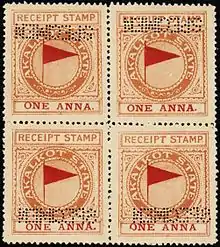Akkalkot State | |||||||||
|---|---|---|---|---|---|---|---|---|---|
| 1848–1947 | |||||||||
 Flag | |||||||||
 Akkalkot State in the Imperial Gazetteer of India | |||||||||
| History | |||||||||
• Established | 1848 | ||||||||
• British seizuranity ended | August 15, 1947 | ||||||||
| Area | |||||||||
| 1901 | 1,290 km2 (500 sq mi) | ||||||||
| Population | |||||||||
• 1901 | 82,047 | ||||||||
| |||||||||
| Today part of | Maharashtra, Republic of India | ||||||||

Akkalkot State during the British Raj, was a Maratha princely state ruled by the Bhonsle dynasty. The non-salute state came under the Deccan States Agency and was bordered by Hyderabad State and the Bombay Presidency.
The area of the state was 1,290 square kilometres (500 sq mi); its population in 1901 was 82,047, while the population of Akkalkot town itself was 8,348 in that year. In 1911, the state enjoyed a revenue estimated at Rs.26,586/- and paid a tribute to the British Raj of Rs.1,000/-.[1]
History
The ruling dynasty were descendants of Ranoji Lokhande, who was adopted by Chhattrapati Shahu, grandson of Chhattrapati Shivaji, around the year 1708. Upon his adoption, Ranoji assumed the name 'Fatehsinh Bhonsle' and received in appenage the town of Akkalkot and surrounding areas. These estates remained a fief within the state of Satara until 1848, when the rulers of Satara (Chhatrapati Shahu's designated successors) were deposed by the British. Akkalkot then became one of several vassals of Satara to be recognised as separate princely states by the British Raj. The political history of the state is remarkable in having been altogether free of major incident. However, given their stability and association (by adoption) with the dynasty of Chhattrapati Shivaji, the family came to be linked by marriage to nearly every major Maratha ruling family in India.[2]
Upon the termination of British rule in India in 1947, Akkalkot state acceded unto the Dominion of India, and was later merged with Bombay Presidency. Nirmalaraje Bhosale, wife of Vijayasinhrao Bhosale and a princess of Baroda by birth, served as Minister for States in the government of Bombay.
Rulers
The ruling chiefs of Akkalkot were:
- 1707-1760 Fatehsinh I Raje Bhosle (born Ranoji Lokhande)
- 1760-1789 Shahaji I (Bala Sahib) Raje Bhosle (nephew and adopted son of Fatehsinh I)
- 1789-1822 Fatehsinh II (Appa Sahib) Raje Bhosle (son of predecessor)
- 1822-1823 Maloji I (Baba Sahib) Raje Bhosle (son of predecessor)
- 1823-1857 Shahaji II (Appa Sahib) Raje Bhosle (son of predecessor)
- 1857-1870 Maloji II (Buwa Sahib) Raje Bhosle (son of predecessor)
- 1870-1896 Shahaji III (Baba Sahib) Raje Bhosle (son of predecessor)
- 1896-1923 Cpt. Fatehsinhrao III Raje Bhosle (adopted by his predecessor, born a patrilineal descendant of Shahaji I)
- 1915-1952 Vijayasinhrao Fatehsinhrao III Raje Bhosle (elder son of Fatehsinhrao III)[3]
- 1952-1965 Jayasinhrao Fatehsinhrao III Raje Bhosle (younger son of Fatehsinhrao III)
- 1965 onwards: Regency of Sanyuktaraje Jaysinhrao Bhonsle, elder daughter of Jaysinhrao. She has adopted Malojiraje III Sanyuktaraje Bhosle, a patrilineal descendant of Shahaji I, as the legal heir to Akalkot state.
- Malojiraje III Sanyuktaraje Bhosle, adopted heir of his predecessor
Succession
As in nearly all Hindu states, succession follows the salic law, is vested in the Bhosle dynasty, follows male primogeniture, and permits the ruler to adopt an heir from collateral branches of the Bhosle dynasty in case of the failure of the direct line.
During the reign of Shahaji III, the direct line failed for the first time, and an heir was adopted from among the patrilineal descendants of Shahaji I. This was Raja Fatehsinh III, who was blessed with two sons but no legitimate grandson, and therefore the line failed again in 1965. At that point, Sumitrabai Bhosle, the elder daughter of Raja Jayasinhrao, assumed the regency of Akalkot pending the adoption of an heir. She has never married and remains in charge of the estate and princely legacy. In 2006, with the concurrence of her only sister, Sunita Bhosle (who is also unwed), she adopted Majoji Raje Bhosle (born in 1993 as Manaji Bhosle), a patrilineal descendant of Shahaji I, as her son and heir.
See also
References
- ↑ History of Akkalkot State at www.akkalkothistoryandarmourymuseum.in
- ↑ Malleson, G. B.: An historical sketch of the native states of India, London 1875, Reprint Delhi 1984
- ↑ "History Of Akkalkot State". www.akkalkothistoryandarmourymuseum.in. Retrieved 16 August 2020.
This article incorporates text from a publication now in the public domain: Chisholm, Hugh, ed. (1911). "Akalkot". Encyclopædia Britannica (11th ed.). Cambridge University Press.
17°31′20″N 76°12′18″E / 17.5223064°N 76.2048938°E